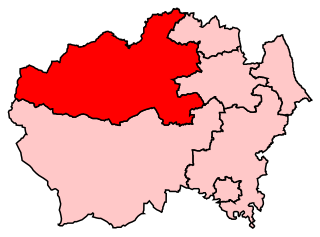Related Research Articles

Wear Valley was, from 1974 to 2009, a local government district in County Durham, England. Its council and district capital was Crook.

Sedgefield is a constituency in County Durham represented in the House of Commons of the UK Parliament since 2019 by Paul Howell of the Conservative Party. It elects one Member of Parliament (MP) by the first past the post system of election.

City of Durham is a constituency represented in the House of Commons of the UK Parliament since 2019 by Mary Foy of the Labour Party.

North West Durham is a constituency represented in the House of Commons of the UK Parliament since 12 December 2019 by Richard Holden of the Conservative Party.

Bishop Auckland is a constituency represented in the House of Commons of the UK Parliament since 2019 by Dehenna Davison, a Conservative.

Stockton-on-Tees is a former borough constituency represented in the House of Commons of the Parliament of the United Kingdom. It elected one Member of Parliament (MP) by the first past the post system of election from 1868 to 1983.

Houghton-le-Spring was a county constituency of the House of Commons of the Parliament of the United Kingdom from 1885 to 1983. Centred on the town of Houghton-le-Spring, now part of the City of Sunderland, it elected one Member of Parliament (MP) by the first-past-the-post system of election.

Crewe was a constituency of the House of Commons of the Parliament of the United Kingdom from 1885 to 1983. It elected one Member of Parliament (MP) by the first past the post system of election.
Ince was a parliamentary constituency in England which elected one Member of Parliament (MP) to the House of Commons of the Parliament of the United Kingdom. It comprised the town of Ince-in-Makerfield and other towns south of Wigan.
Barnard Castle was a county constituency centred on the town of Barnard Castle in County Durham, which returned one Member of Parliament (MP) to the House of Commons of the Parliament of the United Kingdom. It was created for the 1885 general election and abolished for the 1950 general election.

Cleveland was a county constituency in the Langbaurgh Wapentake, North Riding of Yorkshire, England.

Consett was a county constituency, centred on the town of Consett in County Durham. It returned one Member of Parliament (MP) to the House of Commons of the Parliament of the United Kingdom, elected by the first past the post voting system from 1918 to 1983.

Hitchin was a parliamentary constituency in Hertfordshire which returned one Member of Parliament (MP) to the House of Commons of the Parliament of the United Kingdom from 1885 until it was abolished for the 1983 general election.

Chester-le-Street was a county constituency centred on the town of Chester-le-Street in County Durham. It returned one Member of Parliament (MP) to the House of Commons of the Parliament of the United Kingdom from 1885 to 1983.

Enfield was a constituency for the House of Commons of the UK Parliament from 1885 until 1950. The area sloping to the River Lea in the east was in the far north of Middlesex centred on the town of Enfield. The area formed part of the London conurbation and was much reduced over the course of its existence, in 1918 and then insignificantly in 1945 due to suburbanisation and urbanisation. It returned one Member of Parliament (MP).
Mid Durham was a county constituency represented in the House of Commons of the Parliament of the United Kingdom. It elected one Member of Parliament (MP) by the first past the post system of election from 1885 to 1918.
South East Durham was a county constituency represented in the House of Commons of the Parliament of the United Kingdom. It elected one Member of Parliament (MP) by the first past the post system of election between 1885 and 1918.
The county of Durham has returned 7 MPs to the UK Parliament since 1983. Under the Local Government Act 1972, which came into effect on 1 April 1974, the boundaries of the historic/administrative county were significantly altered with the north-east of the county, comprising more than half the electorate, being transferred to the new metropolitan county of Tyne and Wear. In addition, the borough of Hartlepool was included in the new county of Cleveland. These changes were reflected in the following redistribution of parliamentary seats which did not come into effect until the 1983 general election, resulting in a reduction in the county's representation from 16 to 7 MPs.
References
- ↑ Craig, Fred W. S. (1972). Boundaries of parliamentary constituencies 1885-1972;. Chichester: Political Reference Publications. pp. 58–59. ISBN 0-900178-09-4. OCLC 539011.
- ↑ "Representation of the People Act 1918". p. 496.
- ↑ British Parliamentary Election Results 1918-1949, FWS Craig
- ↑ British Parliamentary Election Results 1918-1949, FWS Craig
- ↑ British Parliamentary Election Results 1918-1949, FWS Craig